Use manual focus mode for precise control over your close-up shots. Keep your lens clean to guarantee crisp images. Stabilize your phone using both hands or a tripod to prevent blur. Adjust exposure and ISO settings to fine-tune light and sensitivity. Experiment with different lighting techniques, including natural and artificial sources. Consider trying external macro lenses for enhanced magnification capabilities. After capturing your shots, edit them to bring out hidden details and enhance overall quality. These tips will help you reveal the hidden beauty in everyday objects and transform them into stunning visual stories. There's even more to explore in the world of close-up phone photography.
Use Manual Focus Mode
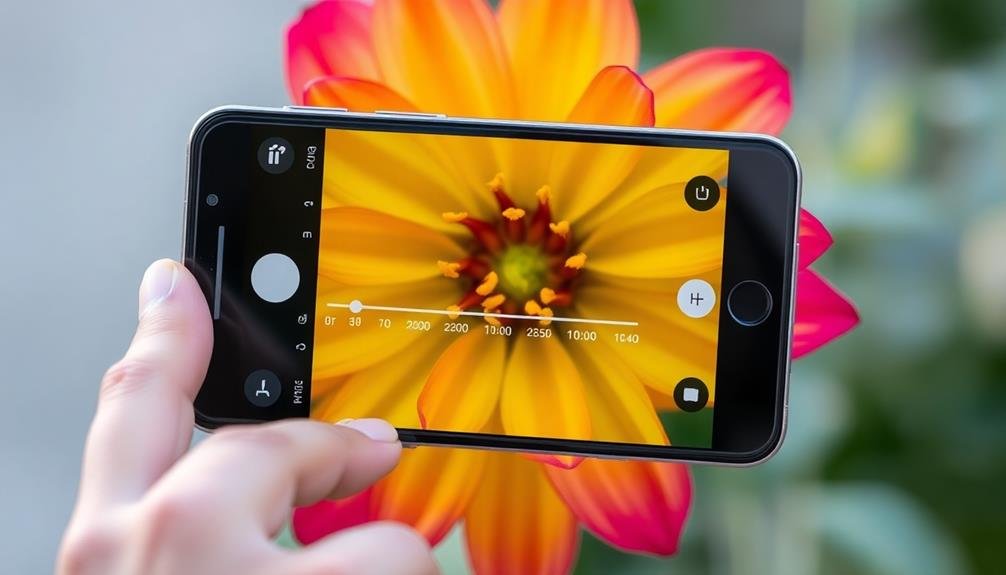
When it comes to close-up phone photography, manual focus mode is your secret weapon. It gives you precise control over what's in focus, allowing you to capture stunning details that auto-focus might miss. To use manual focus, open your phone's camera app and look for the "MF" or focus slider option.
Once you've activated manual focus, you'll see a slider on your screen. Move this to adjust the focus point. For close-ups, you'll typically want to focus on the nearest part of your subject. As you adjust, you'll notice parts of the image becoming sharper or blurrier.
Don't rush this process. Take your time to fine-tune the focus until you're satisfied with the result. You might need to make subtle adjustments to get the perfect shot. Remember, even a slight change can dramatically affect the final image.
Manual focus is particularly useful for macro shots of flowers, insects, or small objects. It lets you highlight specific textures or details that might be overlooked in auto mode.
With practice, you'll develop an eye for selecting the most impactful focus points in your close-up shots.
Clean Your Lens Regularly
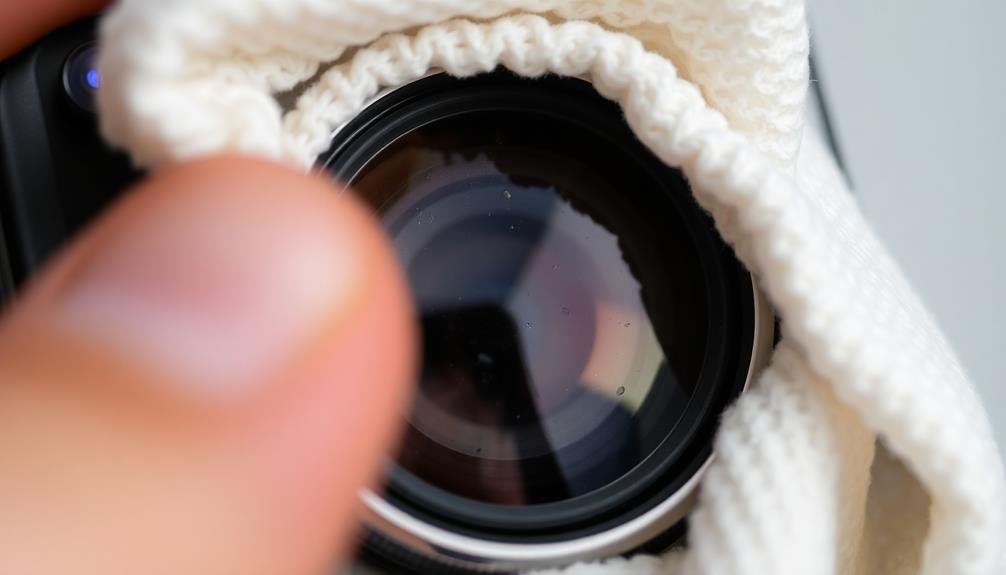
Many smartphone users overlook an essential step in capturing crisp close-up shots: keeping the lens clean. Your phone's camera lens is constantly exposed to various elements, from fingerprints to pocket lint, which can greatly impact image quality.
To guarantee you're always ready to snap stunning close-ups, make it a habit to clean your lens regularly.
Here's a simple routine to keep your phone's camera lens spotless:
- Use a microfiber cloth to gently wipe the lens surface.
- For stubborn smudges, lightly dampen the cloth with distilled water.
- Avoid using harsh chemicals or abrasive materials that could damage the lens coating.
Stabilize Your Smartphone Camera
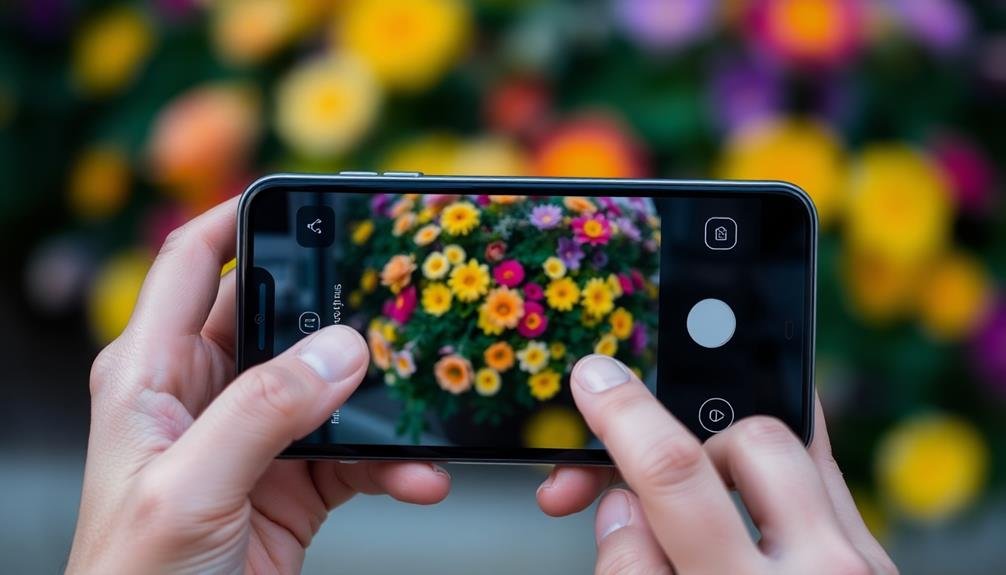
To capture tack-sharp close-up images, stabilizing your smartphone camera is essential. Even the slightest movement can blur your photo, so it's vital to keep your device as still as possible.
Start by adopting a stable stance: plant your feet shoulder-width apart and tuck your elbows into your body. This creates a solid foundation for your shot.
Use both hands to hold your phone, gripping it firmly but not too tightly. If available, utilize your phone's built-in stabilization features or download a camera app with advanced stabilization options.
For extra stability, lean against a wall or rest your arms on a steady surface.
Consider investing in a small tripod designed for smartphones. These compact accessories can dramatically improve your close-up shots, especially in low-light conditions.
If you don't have a tripod, improvise by propping your phone against a stable object.
When taking the shot, use your phone's volume buttons or a Bluetooth remote shutter to avoid tapping the screen, which can cause unwanted movement.
Adjust Exposure and ISO
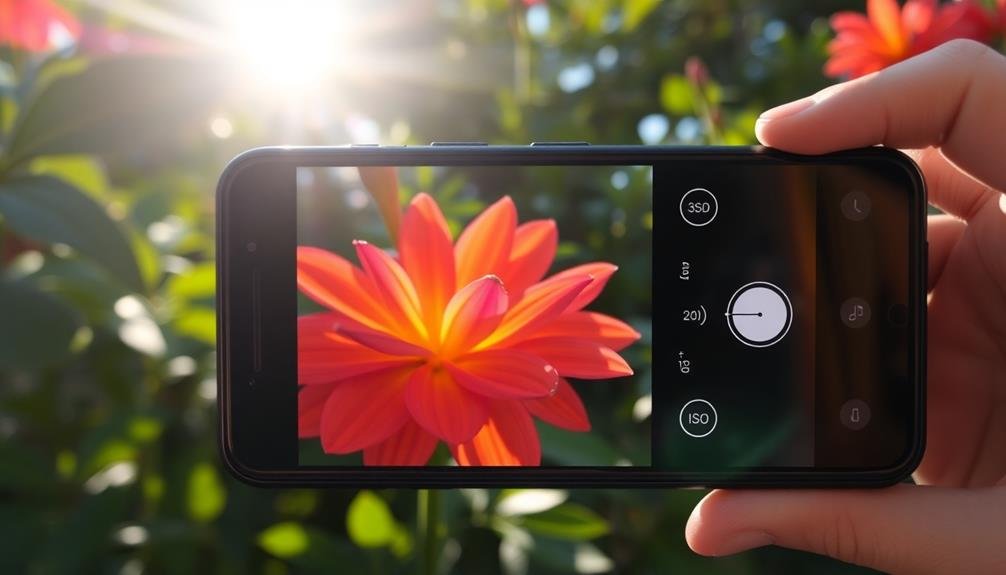
Two key elements for capturing stunning close-up shots are exposure and ISO settings. These controls allow you to fine-tune the amount of light entering your camera and its sensitivity to that light.
When shooting close-ups, you'll often encounter challenging lighting conditions, making it essential to master these settings.
To adjust exposure on most smartphones, tap the screen and look for a sun icon. Slide this up or down to increase or decrease brightness. For ISO, you'll typically find this option in your camera app's "Pro" or "Manual" mode. Higher ISO values increase light sensitivity but can introduce noise, so aim for the lowest workable setting.
Here are three tips to optimize your exposure and ISO for close-up shots:
- Use exposure compensation to prevent overexposure in bright areas
- Experiment with HDR mode for high-contrast scenes
- Increase ISO cautiously in low light, balancing detail and noise
Experiment With Lighting Techniques
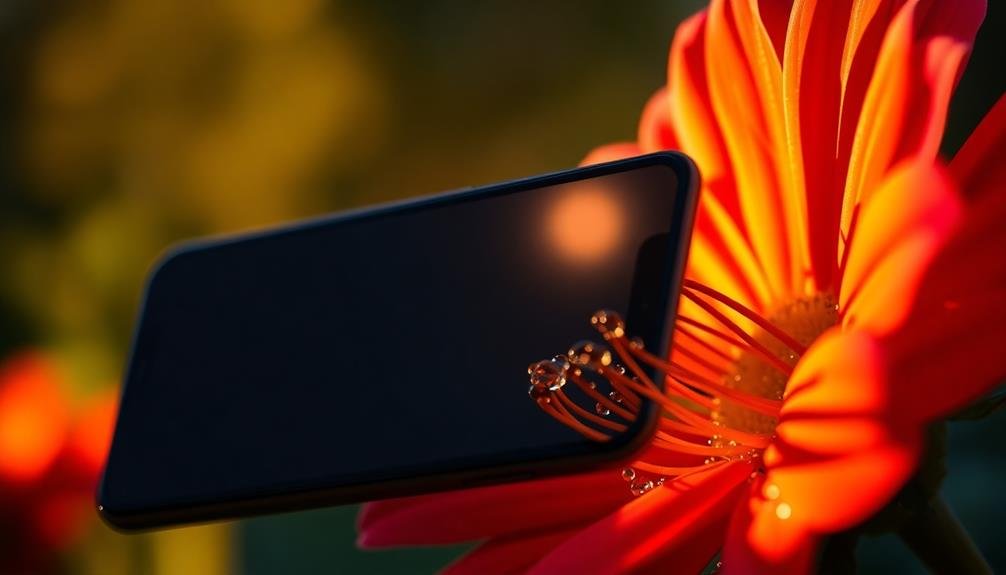
Lighting can make or break your close-up phone photography. To achieve stunning results, you'll need to experiment with various lighting techniques.
Start by exploring natural light sources. Position your subject near a window or in open shade for soft, even illumination. If you're outdoors, try shooting during the golden hour for warm, flattering light.
Don't shy away from artificial lighting. Use a small LED light or ring light to illuminate your subject from different angles. Try backlighting to create a dramatic silhouette effect or side lighting to emphasize texture.
For a professional look, invest in a portable softbox or diffuser to soften harsh shadows.
Get creative with reflectors. Use a white piece of paper or a small mirror to bounce light onto your subject, filling in shadows and adding depth.
Experiment with colored gels or filters to add mood and atmosphere to your close-ups.
Try External Macro Lenses
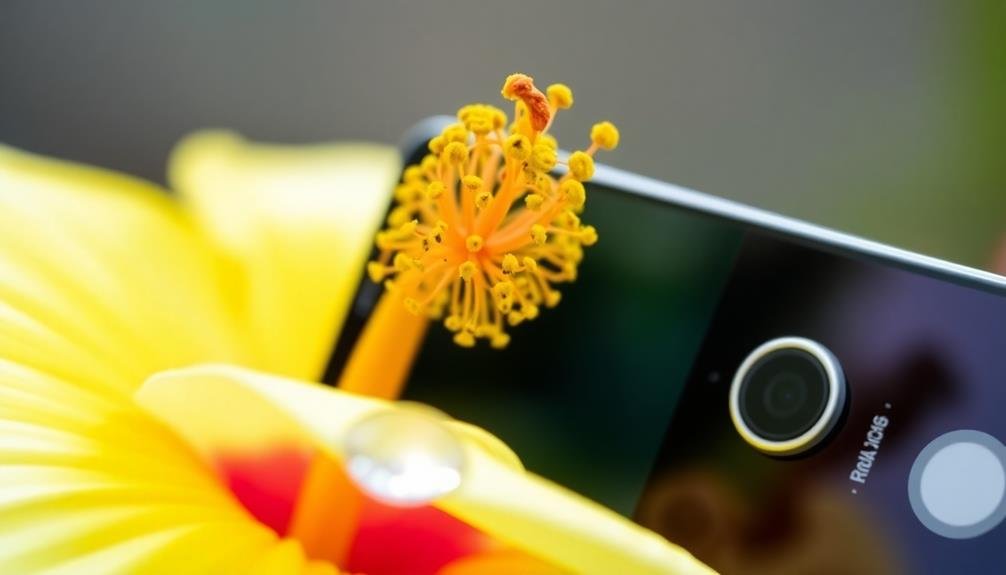
While your phone's built-in camera is impressive, external macro lenses can take your close-up photography to the next level. These affordable accessories clip onto your phone, allowing you to capture intricate details that would otherwise be impossible. When choosing a macro lens, consider the magnification level and compatibility with your device.
To get the most out of your external macro lens:
- Stabilize your phone: Use a tripod or rest your device on a stable surface to minimize camera shake and guarantee sharp images.
- Find the sweet spot: Experiment with different distances between your lens and subject to determine the best focal range for your specific lens.
- Adjust your lighting: Since you'll be working at close range, make sure your subject is well-lit without casting shadows from your phone or lens.
Don't be afraid to get creative with your macro shots. Explore everyday objects from a new perspective, capturing textures, patterns, and details that often go unnoticed.
With practice, you'll develop an eye for interesting subjects and compositions. Remember to clean your lens regularly, as dust and smudges can greatly impact image quality when working at such close range.
Edit for Enhanced Details
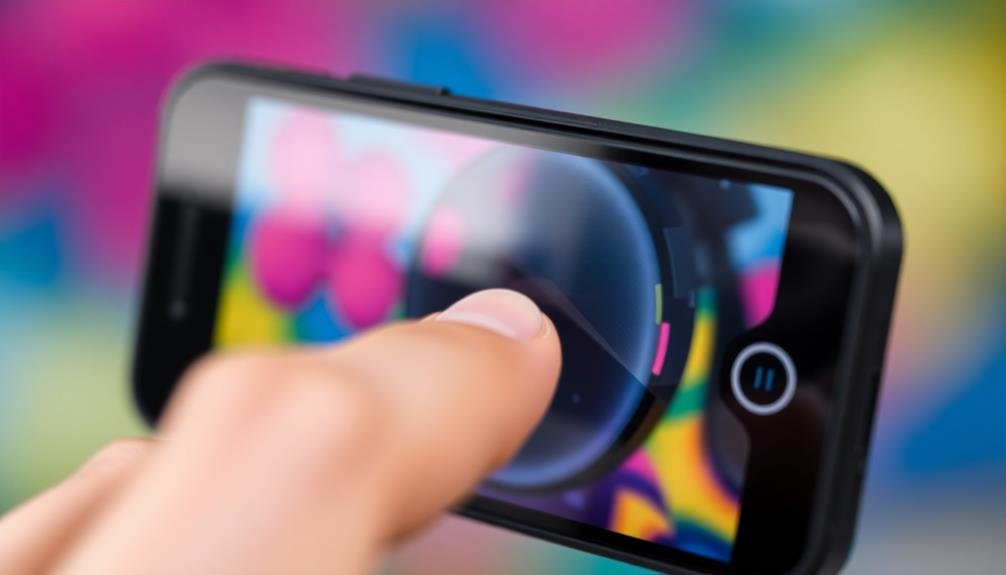
Most close-up shots can benefit from post-processing to bring out the finest details. After capturing your close-up images, use editing apps to enhance their quality.
Start by adjusting the exposure and contrast to make the subject pop. Increase the sharpness slightly to accentuate textures and fine lines, but be careful not to overdo it, as this can create an unnatural look.
Play with the highlights and shadows to reveal hidden details in both bright and dark areas. If your phone's camera app offers HDR mode, use it to capture a wider range of tones.
When editing, experiment with the clarity or structure sliders to add depth and dimension to your close-ups.
Don't forget about color adjustments. Tweaking the saturation and vibrance can make your subject more vivid and eye-catching.
For macro shots of nature, consider boosting the greens and blues slightly. If you're photographing objects, adjust the white balance to guarantee accurate color representation.
Frequently Asked Questions
How Close Can I Get to My Subject With a Smartphone Camera?
You can get quite close with your smartphone camera. Most modern phones allow you to focus on subjects just a few inches away. However, the exact minimum distance varies by device and lens type. Experiment to find your phone's limit.
What's the Best Time of Day for Close-Up Outdoor Photography?
You'll get the best close-up outdoor shots during the "golden hours" – just after sunrise or before sunset. The soft, warm light enhances details and creates beautiful shadows. Overcast days can also provide diffused light for macro photography.
Can I Use Filters for Close-Up Smartphone Photography?
Yes, you can use filters for close-up smartphone photography. They'll enhance colors, reduce glare, and create unique effects. Clip-on lenses or filter apps are great options. Experiment with different filters to find your favorite style and mood.
How Do I Prevent Camera Shake When Taking Close-Up Shots?
To prevent camera shake in close-ups, you'll want to stabilize your phone. Use a tripod or rest it on a stable surface. If handheld, keep your elbows tucked, breathe steadily, and use your phone's timer or voice commands.
Are There Any Apps Specifically Designed for Close-Up Smartphone Photography?
Yes, there are apps designed for close-up smartphone photography. You'll find options like ProCam, Camera+, and Macro Lens. They offer features like focus stacking, exposure control, and digital zoom to enhance your macro shots.
In Summary
You've now got the tools to take stunning close-up shots with your phone. Remember, practice makes perfect. Don't be afraid to experiment with these techniques and find what works best for you. As you hone your skills, you'll capture intricate details and textures you never thought possible with a smartphone. Keep exploring, pushing your camera's limits, and sharing your unique perspective through macro photography. Your next masterpiece is just a shot away!

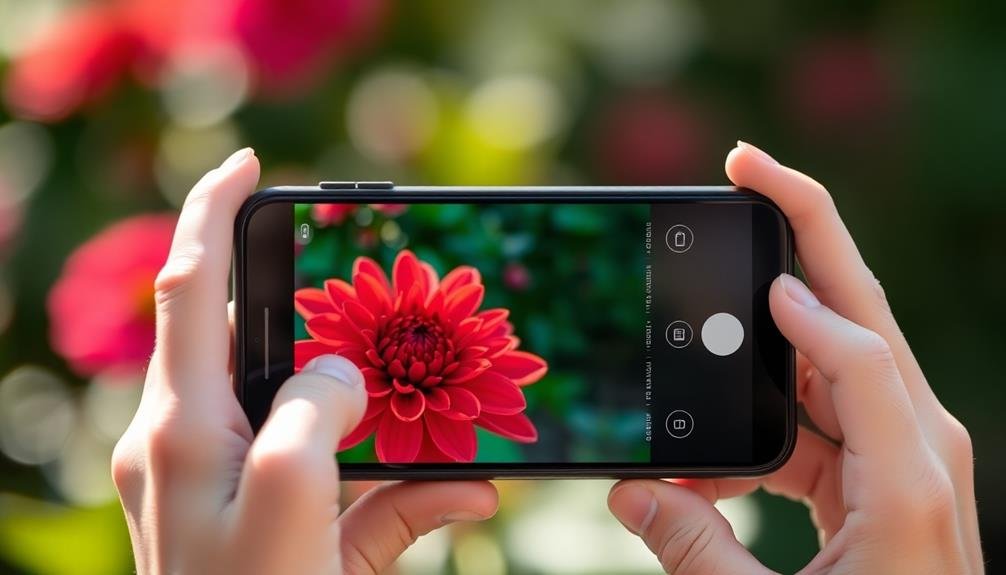



Leave a Reply